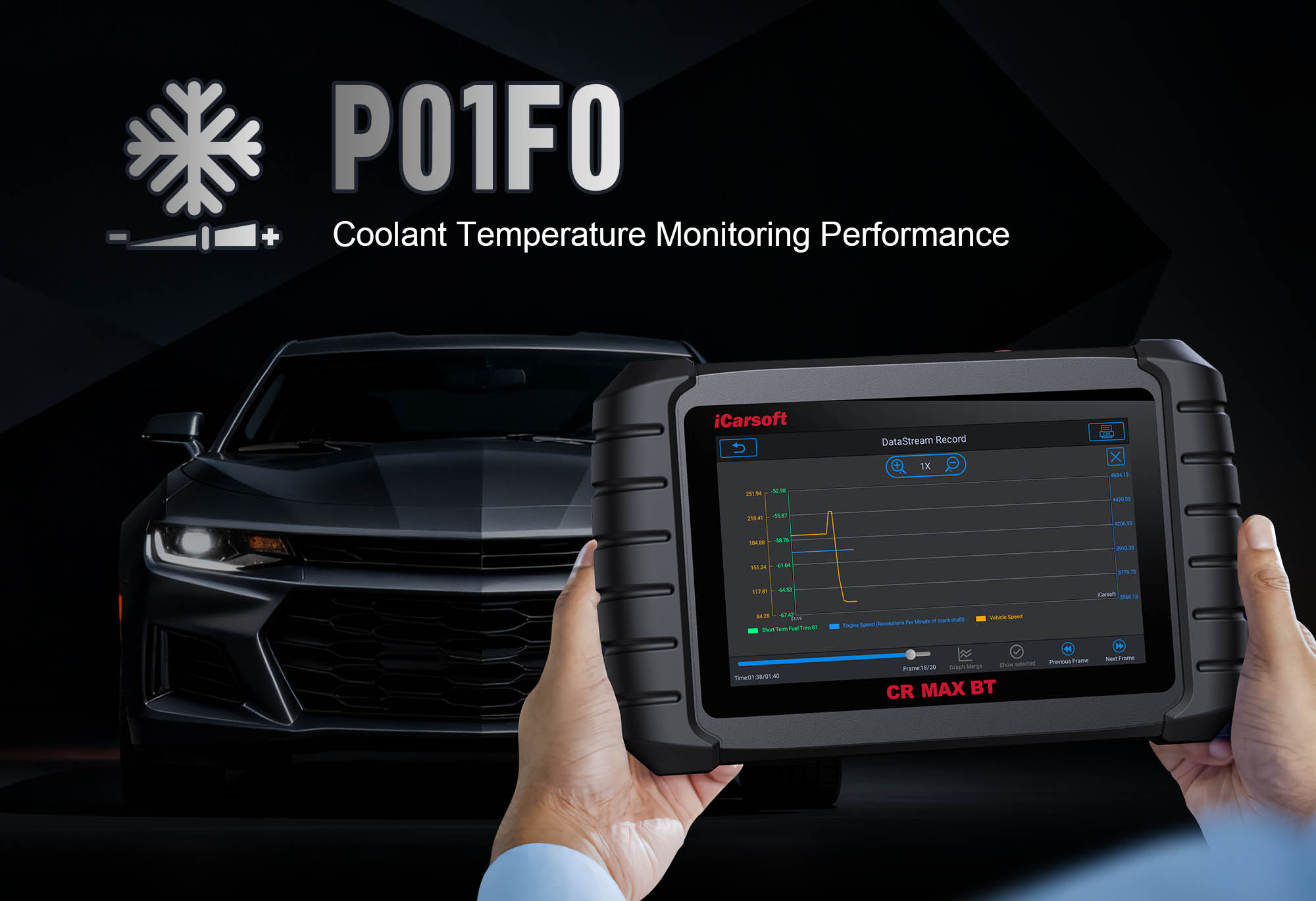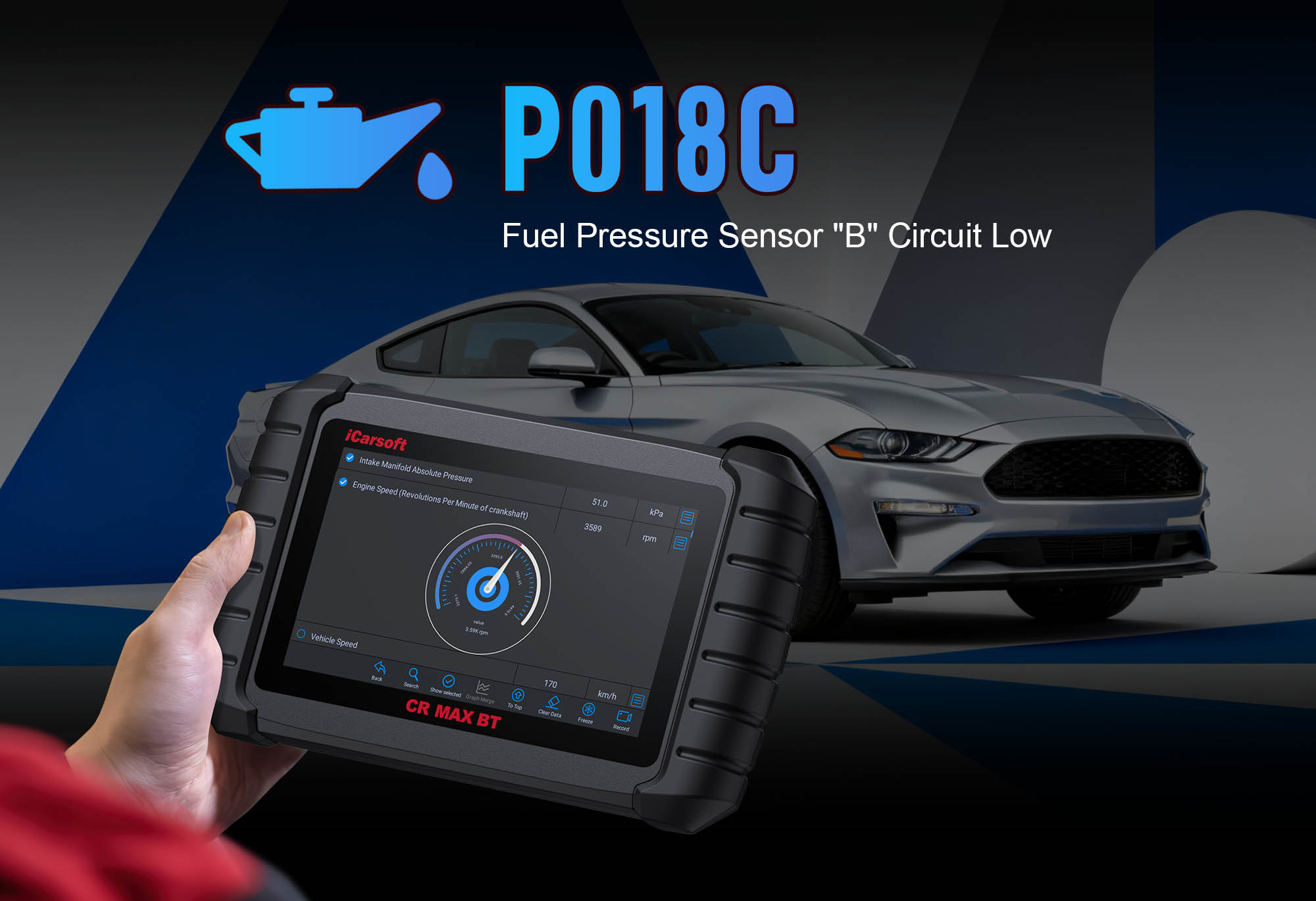Understand & Fix P0160: O2 Sensor Circuit No Activity (Bank 2, Sensor 2) with iCarsoft CR MAX BT
If your vehicle’s Check Engine Light (CEL) stays lit, fuel efficiency drops, or you fail an emissions test, a diagnostic scan may return P0160. This OBD-II code signals "Oxygen (O2) Sensor Circuit No Activity (Bank 2, Sensor 2)"—a fault targeting the downstream oxygen sensor in the second cylinder bank. Unlike upstream sensors (which regulate air-fuel mixture), the downstream sensor (Sensor 2) monitors catalytic converter efficiency; when it stops sending voltage signals to the Engine Control Module (ECM), the ECM logs P0160 to alert you to potential exhaust system issues.
Basic scanners might only label this a "sensor failure," but they can’t distinguish between a faulty O2 sensor, broken wiring, or a failed catalytic converter. This ambiguity often leads to unnecessary sensor replacements (costing $250–$400) when the issue is a $60 wiring repair. The iCarsoft CR MAX BT eliminates guesswork with wireless OE-level diagnostics, bidirectional testing, and 58-brand coverage—making it the ideal tool for fixing P0160 in popular vehicles like the Ford F-150, Chevrolet Silverado, and Toyota Camry. Below, we break down P0160’s causes, symptoms, step-by-step fixes, and 8 FAQs to resolve the issue confidently.
What Exactly Is P0160?
P0160 specifically targets the downstream O2 sensor (Sensor 2) in Bank 2. "Bank 2" refers to the cylinder bank opposite the #1 cylinder, while "Sensor 2" denotes the sensor after the catalytic converter (downstream). This sensor’s job is to verify if the catalytic converter is reducing emissions by comparing upstream (Sensor 1) and downstream oxygen levels. A "no activity" error means the sensor isn’t generating voltage (normal range: 0.1V–0.9V) or sending signals to the ECM—typically due to a failed sensor, broken wiring, or a short circuit.
This code is prevalent in high-mileage vehicles (120,000+ miles) with worn sensors, such as the Ford F-150 P0160 downstream sensor and Chevrolet Silverado P0160 wiring fault. It’s also common in vehicles with damaged exhaust systems, where debris or corrosion disrupts sensor connections.
Key Symptoms of P0160
-
Illuminated Check Engine Light: The primary alert, often paired with a "O2 Sensor Circuit No Response" message in newer models (critical for 2020+ Toyota Camry P0160 CEL).
-
Reduced Fuel Efficiency: A faulty downstream sensor prevents the ECM from optimizing fuel delivery, leading to 10–18% higher fuel consumption (prevalent in high-mileage P0160 vehicles).
-
Emissions Test Failure: A guaranteed fail, as the catalytic converter’s inefficiency raises hydrocarbon and CO2 levels (key for California P0160 smog check).
-
Rough Idling or Hesitation: In severe cases, incorrect exhaust data disrupts combustion, causing the engine to shake at idle or lag during acceleration (e.g., Honda Civic P0160 rough idle).
-
Catalytic Converter Damage: Prolonged P0160 can lead to converter overheating—costing $800–$2,000 to replace.
Common Causes of P0160
|
Cause
|
Description
|
|
Faulty Downstream O2 Sensor
|
Internal element damage (from heat or corrosion) stops voltage generation—top cause in Ford F-150 P0160 sensor failure.
|
|
Wiring/Connector Issues
|
Frayed wires, corroded terminals, or loose connectors break the sensor’s signal path—common in Chevrolet Silverado P0160 wiring damage (exposed to undercarriage debris).
|
|
Short Circuit
|
A wire in the sensor circuit touches the vehicle’s metal frame, causing a constant 0V signal.
|
|
Catalytic Converter Failure
|
A clogged or broken converter stops exhaust flow, preventing the sensor from detecting oxygen changes (e.g., Toyota Camry P0160 catalytic converter).
|
|
ECM Software Glitch
|
Outdated firmware fails to recognize sensor signals, triggering false P0160 codes—common in 2019+ vehicle P0160 software (e.g., Honda Pilot).
|
Why iCarsoft CR MAX BT Excels at Diagnosing P0160
Resolving P0160 requires precise downstream sensor and exhaust system testing—something basic scanners can’t do. The CR MAX BT stands out with exclusive features tailored to this fault:
Wireless Bluetooth Diagnostics
Test from 30+ feet away—no tangled cables, perfect for accessing hard-to-reach O2 sensors (e.g., under Chevrolet Silverado trucks).
Bidirectional Control
Send commands to activate the O2 sensor heater circuit, eliminating false codes from heater failures (top P0160 cause).
58-Brand Vehicle Coverage
Works with all P0160-prone makes: Ford F-150, Toyota Camry, Mercedes-Benz, BMW, and more.
Live O2 Sensor Data Tracking
Monitors real-time voltage (0.1V–0.9V) and response time—spots "no activity" (0V/5V) issues in seconds.
CAN-FD Protocol Compatibility
Supports 2018+ modern vehicles with faster data transmission, ensuring accurate diagnostics for new-model P0160 cases.
7-Inch Touchscreen
Easy-to-navigate interface for switching between live data, fault codes, and bidirectional tests—ideal for DIYers and pros.
Step-by-Step: Diagnose & Fix P0160 with iCarsoft CR MAX BT
-
Confirm P0160 & Gather Vehicle-Specific Data
Plug the CR MAX BT’s OBD-II adapter into the vehicle port and connect via Bluetooth (pair with 7-inch touchscreen quickly).
Select AutoVIN Identify to detect make/model/Bank 2/Sensor 2 location (e.g., rear of catalytic converter for Ford F-150).
Navigate to Engine > Fault Codes > Read Codes to confirm P0160. Tap Code Details for insights (e.g., "Chevrolet Silverado: Voltage 0V; Check Sensor/Wiring").
-
Analyze Live O2 Sensor Data
Go to Engine > Live Data > Oxygen Sensors to monitor three key metrics:
1. Bank 2 Sensor 2 Voltage: Fluctuates 0.1V–0.9V if working; 0V/5V = no activity.
2. Sensor Heater Circuit: Reads 12V (battery voltage) at startup—0V = heater failure.
3. Bank 1 vs. Bank 2 Comparison: Upstream (Sensor 1) voltage fluctuates more than downstream (Sensor 2); no difference = converter failure.
-
Test the Sensor & Wiring with Bidirectional Control
1. Use Bidirectional Test to send "Heater On" command to Bank 2 Sensor 2—voltage stays 0V = faulty sensor.
2. Locate sensor via Component Location tool, disconnect connector. Use Resistance Test (OEM specs 10–20 ohms at room temp)—infinite resistance = faulty sensor.
3. Wiring Test: Use Continuity Test for breaks between sensor and ECM—repair with heat-shrink tubing or replace harness.
-
Repair & Validate the Fix
1. Replace faulty sensor/wiring, or fix exhaust leaks (use Exhaust System Test to spot leaks). Consult pro for converter issues (tool flags "low efficiency" in live data).
2. Run O2 Sensor Reset to sync new sensor to ECM. Clear P0160 via Fault Codes > Clear Codes, test drive 50 miles.
3. Re-scan with CR MAX BT—stable voltage fluctuations in Bank 2 Sensor 2 = issue resolved.
FAQs: Your P0160 Questions Answered
Can I drive with P0160, or will it damage my vehicle?
Short trips (to a repair shop) are safe, but prolonged driving risks catalytic converter damage. Avoid heavy loads—critical for Ford F-150 P0160 towing scenarios.
How much does it cost to fix P0160?
Downstream O2 sensor replacement = $250–$400 (parts + labor), wiring repairs = $60–$150. The CR MAX BT saves $100+ on diagnostics and avoids unnecessary sensor swaps.
Why does P0160 keep coming back after sensor replacement?
Hidden issues like wiring short P0160 or failing catalytic converter are likely. Use the CR MAX BT’s continuity test and live data to rule out these causes.
Is P0160 the same as P0130 (Bank 1, Sensor 1)?
No—P0160 = Bank 2, Sensor 2 (downstream); P0130 = Bank 1, Sensor 1 (upstream). The CR MAX BT’s code details clarify differences with location guides.
Can a dirty air filter cause P0160?
Indirectly—clogged filter causes lean mixtures, overworking the catalytic converter and sensor. Replace the filter and retest with the CR MAX BT.
Does the CR MAX BT work for hybrid vehicles (e.g., Toyota Prius) with P0160?
Yes—supports hybrids with hybrid-specific O2 tests, ensuring accurate diagnostics for electric-assisted engine P0160 cases.
Will P0160 fail emissions tests?
Yes—"no activity" means the converter isn’t monitored, leading to failure. Fix P0160 with the CR MAX BT to pass California P0160 smog checks.
How often should I update the CR MAX BT’s software?
Lifetime free Wi-Fi updates (one-click via touchscreen) ensure compatibility with new vehicles—update every 3 months to handle 2024+ model P0160 cases.
Conclusion
P0160’s "no activity" issue may seem daunting, but the iCarsoft CR MAX BT simplifies diagnostics with wireless convenience, bidirectional testing, and 58-brand coverage. Whether you’re fixing a faulty sensor in a Ford F-150 or wiring in a Chevrolet Silverado, this tool saves time, money, and frustration.
Don’t let P0160 damage your catalytic converter or fail emissions tests. Invest in the CR MAX BT today and take control of your vehicle’s exhaust system health.




